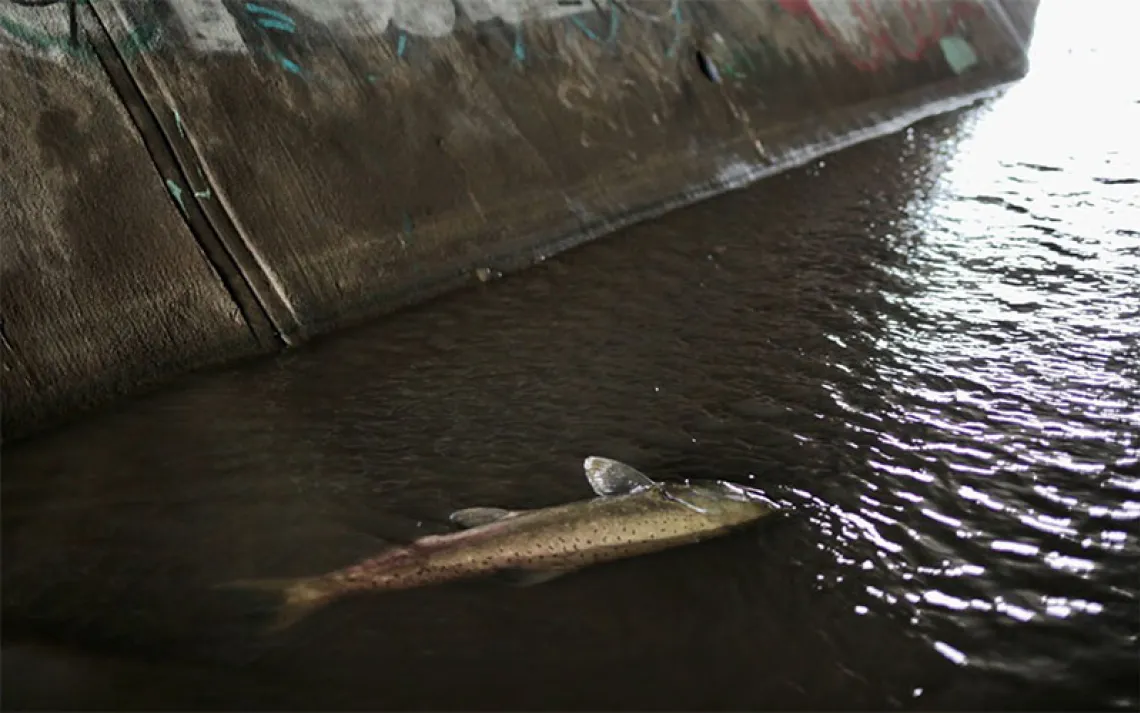A Song of Bats and Fire
Wildfire may help bats adapt to climate change and white-nose syndrome

The Yuma myotis, a small bat native to California's Sierra Nevada, pursues a moth. | Photo by Michael Durham and courtesy of Bat Conservation International
In early fall 2013, a hunter lost control of an illegal campfire in the steep, rugged canyons of the Stanislaus National Forest, just north of Yosemite National Park. One of the longest droughts in recorded history had turned the canyon into a tinderbox, and the blaze grew to what was then the third-largest wildfire in California history. The Rim Fire burned for 28 days, consuming 11 homes and 257,314 acres of forest.
The fire was also an unexpected boon to bats, according to new research published this month in Scientific Report. Between 2014 and 2017, Zachary Steel, a postdoctoral researcher at the University of California, Berkeley, and the lead author of the study, visited areas in the Sierra Nevada burned by the Rim Fire and two other wildfires. He placed bat detectors—microphones capable of recording a bat’s high-pitched squeaks—throughout the burned areas. Over the course of 1,274 nights, he collected recordings of each of the 17 different bat species that occur in the Sierra Nevada.
The recordings revealed that the number of bat species present in a habitat increased in areas where tree mortality was highest. The more trees the wildfire killed, the more species of bats Steel found.

A Townsend's big-eared bat pursues a Spanworth moth. | Photo by Michael Durham and courtesy of Bat Conservation International
Before Europeans colonized California, the areas Steel studied would have seen wildfires as often as every seven years. The land was a mosaic of plant communities in different stages of succession from dark forests to open meadows—what scientists call “pyrodiversity.” But a century of fire suppression by federal agencies who viewed fire as a danger to be snuffed out has turned much of the Sierra Nevada into a dense forest of ponderosa pine and Douglas fir.

Sign up to receive Sierra News & Views
Get articles like this one sent directly to your inbox weekly.
With this action you affirm you want to receive Sierra Club communications and may vote on policy designated by the Sierra Club Board.
The Rim Fire hadn’t brought the Stanislaus National Forest back to its original diversity—but it appeared to have made it, at least temporarily, a better environment for bats. Dead trees and snags left behind were ideal roosting spots. Even more important, by clearing the overgrown stands of forest, the fire expanded the bats’ foraging habitat and made it easier for them to fly.
“It’s a common mythology that bats are blind,” said Winifred Frick, the chief scientist at Bat Conservation International and a coauthor of the new paper. Their eyesight is just as good as ours, which is to say not good enough to pluck flying insects out of the twilight.
To navigate at night, bats have evolved to use a form of sonar called echolocation. They emit a high-frequency pulse of sound—they squeak—then listen for the echo of that squeak as it bounces off branches, leaves, and insects. By doing this, bats are able to create an ultrasonic view of the world around them. It’s a wildly successful strategy for catching prey. A single little brown bat, which is no bigger than your thumb, can eat its entire body weight in insects each night.

A long-eared myotis chases a forest moth. | Photo by Michael Durham and courtesy of Bat Conservation International
Each bat species Steel studies has developed its own echolocation strategies for flying at night. Although all of the squeaks and clicks bats make during echolocation are ultrasonic—meaning they’re above 20 kilohertz and out of our hearing range—some are more high-pitched than others. As a general rule, higher-pitched sounds will create higher-resolution images of a bat’s environment. So a species like the Yuma myotis, which echolocates in quick, high-pitched bursts, is good at maneuvering through dense, overgrown patches of forest. Other species, such as the hoary bat and pallid bat, emit low sounds that travel slower but farther. They’re better at flying in open spaces, such as over grasslands and lakes or above the forest canopy.
Steel assumed, before he crunched the data he had collected, that it would show a decrease in the number of small, high-pitched echolocators throughout the burned areas. To his surprise, only one species—the small-footed bat—had declined in numbers after the wildfires. He’s not positive, but he suspects that forests in the Sierra Nevada have become so overgrown that even clutter-tolerant bat species were having a hard time maneuvering.
Another possible reason for the increase in bat numbers is that the wide-open spaces left behind by a wildfire can produce more food. Steel’s colleagues at UC Berkeley have documented how, in parts of the Sierra Nevada where wildfires have been left to burn naturally, dense forest has been replaced with wetlands. More wetlands means more insects such as mosquitoes, which bats eat.

Lower-frequency echolocations help the large pallid bat search for insects over open grasslands. | Photo by J. Scott Altenbach and courtesy of Bat Conservation International
It’s a tough world out there for bats—they’re facing down habitat loss; the effects of climate change, including drought; and wind farms built along migratory corridors. White-nose syndrome, an invasive fungal disease that wakes bats from their hibernation, causing them to die from exposure, has killed more than 6 million bats across North America. In July, ecologists for the California Department of Fish and Wildlife announced they detected the fungus responsible for white-nose syndrome in bats south of Lassen National Volcanic Park.
Reintroducing fire into prime bat habitat is one way to improve bats’ resiliency to these threats, Steel said. “If we’re able to reintroduce fire to the Sierra Nevada, that’s going to improve habitat,” Steel said. “If you have better habitat, you’ll have healthier bat populations that are more likely to withstand the threats caused by climate change.”
Right now, just two wilderness areas in the Sierra Nevada have managed wildfire plans, which allow fires started by lightning to burn themselves out. One is the Illilouette Creek Basin, in Yosemite National Park, and the other is in Sequoia and Kings Canyon National Parks. Prescribed fire, where fires are deliberately set during times of low wildfire risk, is also a potential solution, but Steel said it’s not quite as good for bats as managed wildfire. That’s because the typical goal of a prescribed burn is to produce a low-severity fire that clears out underbrush but leaves most trees unharmed.
Steel is quick to point out that he’s not a fan of all wildfires. He grew up in Chico, just miles west of Paradise, where the Camp Fire leveled almost 19,000 buildings and killed 85 people in the fall of 2018. In the last decade, California has seen five of the largest wildfires in the state’s history and seven of its most destructive. The Rim Fire was devastating for wildlife that was caught in the initial blaze, and wildfires destroy nesting sites and create other problems for wildlife. The King Fire, which burned almost 98,000 acres of the El Dorado National Forest in 2014, had detrimental effects on spotted owls. “There are winners and losers,” Steel said. “But if you get that high pyrodiversity, you can accommodate a lot more species.”
For bats—along with other forms of wildlife, including birds, bees, and certain kinds of plants—the absence of fire from the dry mountain forests of the Sierra Nevada has been a quiet catastrophe.
 The Magazine of The Sierra Club
The Magazine of The Sierra Club



